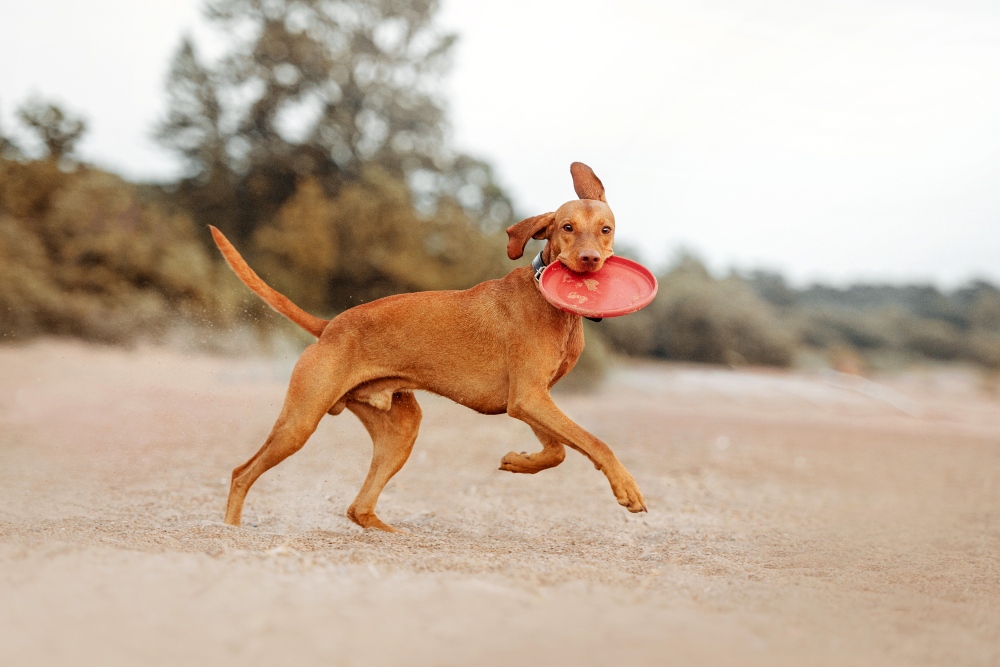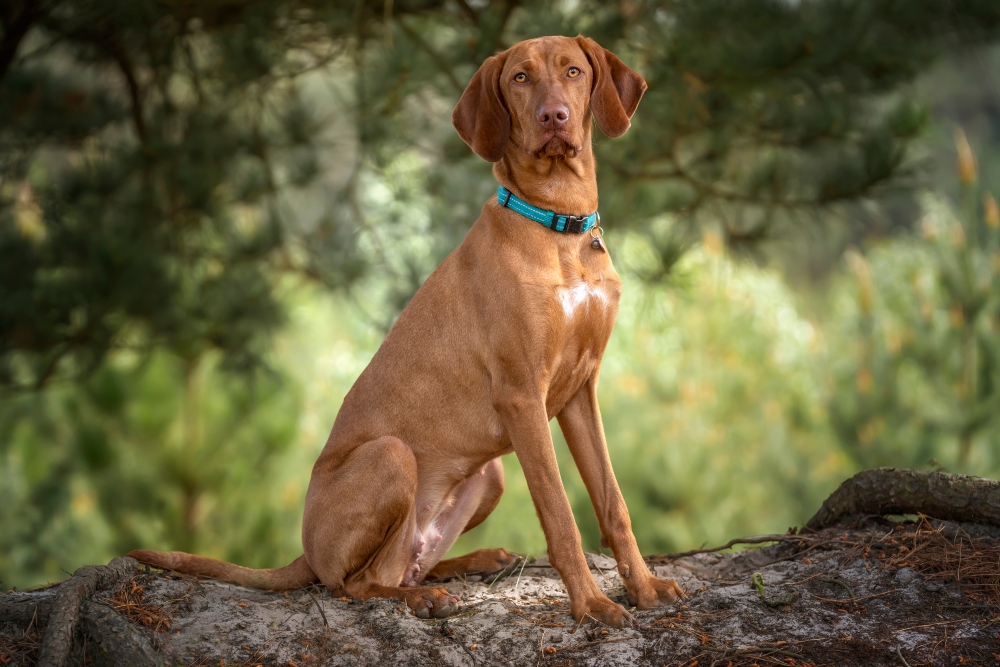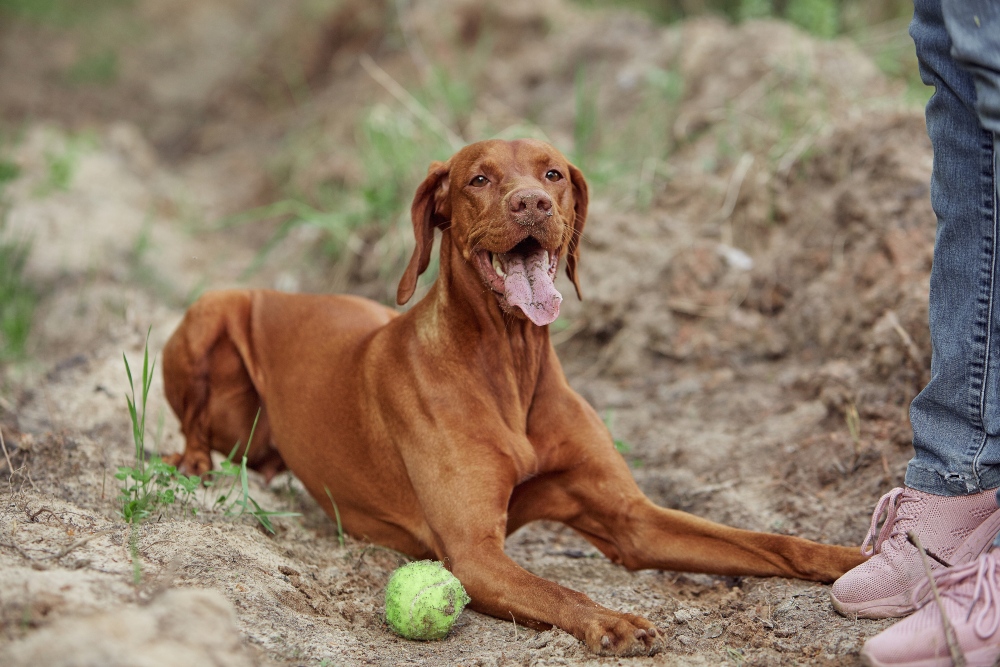Table of Contents
Introduction to Vizslas
Originating in Hungary, vizslas are Sporting Group dogs that are medium-sized, gentle, and affectionate. They are also energetic dogs that do great with active families that can give them plenty of exercise and outdoor opportunities. The vizsla is a versatile dog breed that is easily recognizable and forms tight bonds with their family members.
If all of these characteristics sound appealing to you in a canine companion, then read on to learn more about the vizsla and how to take the best care of your vizsla’s health.
Size of Vizslas
A male vizsla will weigh between 50 and 60 pounds and stand 22 to 24 inches tall when fully grown. Female vizslas are about 44 to 55 pounds and 21 to 23 inches in height.
These are sleek and lean dogs that grow until about one year of age. However, it may take a few extra months for your dog to muscularly fill out completely. Female vizslas weigh about 10 pounds less than males when they first start growing, and there can be significant variance between smaller and bigger male dogs.
Here’s how big you can expect your vizsla to get when fully grown. Male weights are on the higher end of these ranges, while female weights are on the lower end.
| Weight Chart | 3 months | 6 months | 9 months | 12 months |
| Male and female vizslas | 17-24 lbs. | 32-45 lbs. | 39-56 lbs. | 48-61 lbs. |
Characteristics of Vizslas
Vizslas love being outdoors in various ways, such as running, hunting, and hiking. These are very people-oriented dogs that are devoted companions. However, they might be too much to handle for a first-time pet parent who has limited experience with dogs. They do better in warm weather than cold weather, are easy to groom, and are easy to train as well.
As you get to know a vizsla’s personality, here’s what you can expect based on his or her breed characteristics:
| Breed Characteristic | Level (High, Medium, Low) |
| Affectionate with People | High |
| Good with Kids | High |
| Good with Pets | High |
| Need for Exercise | High |
| Energy Level | High |
| Intelligence Level | Medium |
| Able to Be Trained | High |
| Amount of Barking | High |
| Amount of Shedding | Low |

History of Vizslas
Magyar warriors first bred vizslas, along with their horses, to be fast, tough, and agile. These troops set out from Russia to conquer much of Western Europe, and their dogs needed to be able to keep up with this lifestyle. These dogs were the ancestors of the modern vizsla. Hungarian nobility and war leaders bred these dogs to become mostly what they exist as today. The dogs were often used for hunting birds and rabbits. They have been referred to as the Hungarian pointer and are described in 10th-century art and 14th-century literature.
In 1950, a vizsla was smuggled out of Hungary and was the first of these dogs to come to America. The American Kennel Club first recognized the vizsla as a breed in 1960. The Vizsla Club of America formed a few years earlier, in 1954. Years later, a vizsla named Chartay was the first dog in the club’s history to win championships in five different sports. Today, you’ll find vizslas working various kinds of jobs and having a moderately popular status.
Vizsla Standard Information
Vizslas are short-coated hunting dogs that are medium-sized and agile. They are versatile dogs that have great drive and endurance. Did you know that vizslas are among the fastest dogs in the world and can run as fast as 40 miles per hour?
There are certain characteristics of vizslas that dog show judges compare to determine winners. According to the American Kennel Club, here is an overview of the breed standard information for vizslas:
Head:
- Lean and muscular head
- Moderately wide skull between ears
- Muzzle square and deep
- Ears thin and silky
- Medium-size eyes
- Whisker removal permitted but not preferred
Neck, Topline, Body:
- Strong, smooth, and muscular neck
- Strong and well-proportioned body
- High withers
- Slightly longer than tall overall
- Tail set just below the level of the croup
Forequarters:
- Shoulder blades proportionately long and wide
- Nails brown and short
- Pads tough and thick
- Removal of dewclaws strongly recommended to prevent running injuries
Hindquarters:
- Well-developed thighs
- Hocks well let-down and parallel
Coat:
- Short, dense, smooth, and close-lying
- No woolly undercoat or distinctly long coat
Color:
- Varying shades of golden rust
- White markings permitted in certain areas
- Self-colored with various parts blending in with the color of the coat
Gait:
- Light-footed, graceful, and smooth gait
- Single tracks when moving at a fast trot

Caring for Vizslas
Vizslas need human companions that are active and like the great outdoors. These dogs enjoy all forms of outdoor activity and prefer that kind of lifestyle over being a couch potato at home. Although many people think that a vizsla could not be happy living in an apartment, they can do well in small spaces as long as their families go on frequent excursions in the neighborhood or out in nature.
Here are some general tips for taking the best care of a vizsla.
Best Living Environments:
- Houses with a fenced yard
- Apartments are not ideal unless pet parents take them outdoors a lot
- Don’t leave the dog outside on its own for long periods of time
- Best in households where people are home most of the time
Type of Exercise:
- Swimming
- Hiking
- Running
- Hunting
Mental Enrichment:
- Lots of personal attention
- Games of fetch
- Chew toys for mental stimulation
Training Strategies:
- Needs consistent and positive training from an early age
- Can be very curious and even manipulative dogs
- May find creative ways to get into trouble if they don’t get attention
- Try hunting tests, barn hunts, dock diving, scent work, and tracking
Grooming Tips:
- Grooming is relatively easy and straightforward
- Brush with a rubber brush to handle shedding
- Bathe when the dog gets dirty
- Keep toenails short
- Check ears for dirt and wax buildup
Common Health Problems of Vizslas
One of the best things about the vizsla is that, compared to other breeds, this breed of dog is not prone to nearly as many health problems. In fact, these dogs typically live for 12 to 14 years. These healthy dogs can get sick with old age, however, so it is smart to enroll your pup in Healthy Paws pet insurance as early as possible.
These are some of the most common health issues that arise with vizslas:
- Hip dysplasia
- Epilepsy
- Hypothyroidism
- Lymphosarcoma
- Progressive retinal atrophy

Diet and Nutrition for Vizslas
The average vizsla will need about three to four cups of dog food daily when fully grown. This total amount of food should be divided into two meals per day. Some recommended commercial dog foods for vizslas are Acana Wholesome Grains Dry Dog Food, and American Journey Active Life Formula.
Keep in mind that grain-free dog foods are currently being investigated by the Food and Drug Administration for a possible link to a heart condition in dogs called dilated cardiomyopathy. Talk with your veterinarian before feeding your vizsla a grain-free food.
Where to Adopt or Purchase Vizslas
If you are looking to purchase a pure vizsla, a good place to start is the Vizsla Club of America. Not only does the club’s website offer resources to find a reputable breeder, but it also lists rescue coordinators with contact information in every region across America.
Vizslas make wonderful pets and often behave like puppies until they are about three years old. Therefore, it is often recommended that busy families with limited amounts of time to train a vizsla choose a housebroken adult dog instead of a new puppy.
Related Breeds
Have you been intrigued and captivated by vizsla dogs? Then you might also be interested to learn about these similar dog breeds that share some of the same characteristics and appearance:
- Weimaraner
- Irish setter
- Golden retriever
- Labrador
- Greyhound
- Dalmatian
- Rhodesian ridgeback
- English pointer
Pet Insurance for Vizslas
It’s hard not to love a vizsla when one comes into your life, and we know you want to do everything in your power to keep your vizsla safe and protected from pain and harm. Since these are active and outdoorsy dogs, accidents are common, which could send your vizsla to an animal emergency room and result in costly veterinary treatments.
Fortunately, Healthy Paws offers vizsla pet insurance to cover these mishaps, breed-specific conditions, genetic conditions, and alternative care. We will set you up with our budget-friendly pet insurance plan with flexible premium and deductible options and no maximum limit on claim payouts.
If you are ready to take control of your vizsla’s health instead of just wishing and hoping nothing bad ever happens, contact us today. We offer pet insurance quotes on our website so that you can make the best decision for your vizsla and your family.









